Canopy research is key to understanding rainforests
An interview with canopy expert Dr. Meg Lowman:
Canopy research is key to understanding rainforests
Rhett A. Butler, mongabay.com
November 28, 2006
Home to perhaps half the world’s terrestrial species, rainforests are the most biodiverse ecosystems on the planet. However, when one strolls through the forest, this biodiversity is rarely apparent for the simple reason that most activity in the rainforest occurs in the canopy, a layer of overlapping branches and leaves some 60-120 feet off the ground. Here, a wealth of ecological niches creates opportunities for plants and animals, including species generally considered to be ground-dwellers: crabs, kangaroos, and even earthworms.
Beyond housing biodiversity, the canopy is the power source of the rainforest, with billions of tree leaves acting as miniature solar panels to convert sunlight into energy through photosynthesis. Since the rate of photosynthesis of canopy trees is so high, these plants generate higher yields of fruits, seeds, flowers, and leaves which attract and support a wide diversity of animal life. Further, as the principal site of the interchange of heat, water vapor, and atmospheric gases, the canopy also plays an important role in regulating regional and global climate.
For these reasons, understanding the canopy is key to understanding the rainforest. Yet due to its inaccessibility, still much is unknown about this rich layer. Early attempts to learn more about the canopy ranged from hiring natives to climb trees to painstakingly training monkeys to bring down plant samples without eating them. In the 1970s scientists began to use mountaineering techniques and ropes to access the canopy and platforms for long-term surveillance, while the 1980s saw ever more elaborate ways to study the treetops. Today you can find cranes, canopy walkways, ultra-lite planes, dirigible balloons and balloon-rafts, ski-lift-style trams, and remote-controlled pulley systems being employed to provide access to the canopy.
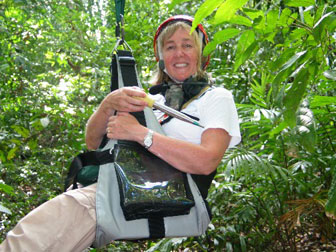 Lowman in the rainforest canopy in Panama. |
Familiar with these efforts is Dr. Margaret D. Lowman, Director of Environmental Initiatives at New College of Florida. Known as “CanopyMeg” to her friends, Lowman has been exploring the rainforest canopy for over 25 years, developing an expertise for the use of different canopy access techniques while authoring over 95 peer-reviewed publications and three books. Recognized as a world-renowned canopy expert, Lowman today focuses on science education and rainforest conservation, and frequently speaks about her adventures to groups ranging from elementary school classes to corporate executives.
In November 2006, Lowman answered some questions from mongabay.com on her passion and outlook for tropical forests.
Mongabay: You’ve been involved in some pretty incredible forms of canopy research. What was it like to be part of the canopy raft expedition in French Guiana? Was this an effective way to do research?
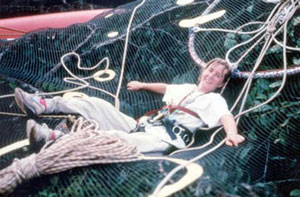 Lowman on the canopy raft in West Africa. 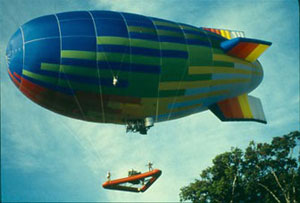 Lowering the canopy raft on Jason VX – Expedition to Panama. 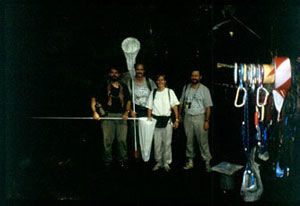 Lowman with other scientists on the canopy raft expedition in French Guiana (1996). |
Lowman: The raft and hot air balloon are definitely the MOST FUN canopy access tools that I have ever experienced. I felt like Dorothy in the Wizard of Oz. In addition, these are the best methods for reaching multiple trees and their uppermost branches (not possible with ropes or walkways). The other advantage of the raft/balloon is that these expeditions are usually international in scope, and command some of the best canopy researchers to convene in one place. Hence, the value of the data is multiplied by sharing and collaborating.
Mongabay: Whatever happened to the canopy raft? Has it been re-deployed?
Lowman:
The raft is only used when adequate funding can be raised to deploy it. Pro-NaturA (in Europe) has taken on some of the responsibility of fund-raising, now that Francis Halle is retired. They have plans for Vanuatu this fall, and perhaps Australia next year. Sadly, it is fairly difficult for ecologists to raise the estimated $1 million it takes to fund 50 scientists to study the treetops of planet Earth with this technique (yet we are spending hundreds of millions to study places far from our home).
Mongabay: Have methods for accessing the canopy improved in recent years or is it still a matter of being skilled with ropes and having a sense of adventure?
Lowman:
Methods have definitely improved. The ropes and harnesses are fairly limited (but still good for low-budget research). Walkways, cranes, and hot air balloons — we well as towers — offer improved canopy access under different weather conditions, for different heights, and for asking different questions about the forest.
Mongabay: What can the canopy tell us about the overall health of a forest?
Lowman:
The canopy is the action spot in the forest — where the bulk of photosynthesis occurs, where the hotspot of biodiversity is found — the epi-center for leaves, fruits, flowers and the animals that depend on them. It is in essence the mainframe computer for running the forest. Obviously, the health of the canopy affects all the others parts. Subsequently, insect outbreaks in canopy leaves, acid rain or other pollutants, or perhaps changes in atmospheric conditions with climate change may indeed impact the canopy and degrade the health of forests overall.
Mongabay: What’s your outlook for tropical forests?
Lowman:
I am not optimistic about the accelerated impacts that humans are having on all ecosystems, especially tropical forests. My best hope lies with the next generation and their skills, perception, and passion for fixing what our generation has caused. This is why I am passionate about teaching and working to inspire the next generation to become field biologists. We need their talents, and we need them quickly to find solutions to current problems.
Mongabay: What would you change about current conservation strategies to make them more effective? What’s the best way to save rainforests?
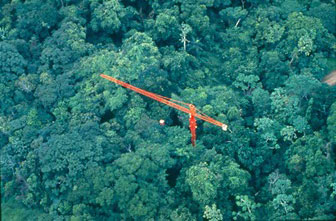 The Smithsonian Tropical Research Institute’s Canopy Crane Access System in Panama |
Lowman:
I think we need to dedicate ourselves to ecotourism. Although this results in more people trampling in beautiful places, it is a very forceful mechanism for conservation and also brings revenue to local people without selling their timber. We also need strong leadership to inspire people to immediately adhere to stricter conservation measures — driving hybrid cars, flying less or more cautiously because of the carbon emissions, working hard to lower the ecological footprint (for Americans, that is), and reviving the science education in our country.
Mongabay: What role does education, both in tropical countries and here in the United States, play in conservation?
Lowman:
As stated above, education is the absolute essential ingredient to future solutions. I have a new mantra “no child left indoors” based on my recent story of my own children working me in the rain forest (Its a Jungle UP There, co-authored by me and my two sons, Eddie and James Burgess is recently published by Yale University Press). By giving young people a connection to ecosystems, we will create good stewardship for the future.
Mongabay: What can people do at home to help conserve rainforests?
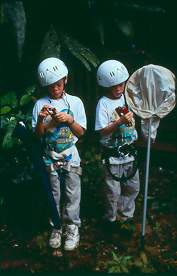 Lowman’s children, Eddie and James, setting out for their first climb at mom’s research site in Blue Creek, Belize. Kathryn Lasky wrote a children’s book, The Most Beautiful Roof in the World, describing this adventure to the rain forest with mom and children. |
Lowman:
1. Educate others — buy rain forests books for local libraries and as birthday gifts; take kids on hikes into nature; volunteer in local middle school science classes; and make science fun!
2. Shop carefully — be mindful of products that accelerate rain forest clearing (soy, etc) and advocate for stores to include labels as to where products originated especially foods and woods.
3. Adopt a stewardship attitude in general — buy a hybrid, ride a bike, plant trees (sounds silly but it works!), recycle, support ecotourism, support scholarships for students from developing countries (I run a foundation, www.treefoundation.org where we bring up several students each year so they can learn about the latest conservation ideas and scientific tools). And most challenging of all — try to educate others to lower their ecological footprints.
Mongabay: You have two sons. Are they passionate about the rainforest? What do they find most interesting?
Lowman:
I suggest you read their chapters in our book, Its a Jungle UP There — they are indeed passionate but they write about it so much better than I could repeat it!!
Mongabay: What’s your most memorable rainforest experience?
Lowman:
Two — chapter two in Its a Jungle Up There (in Western Samoa) and chapters 7 and 9 — sharing the Amazon with my children and with students.
Mongabay: Do you have any advice for students wanting to pursue a career in rainforest research?
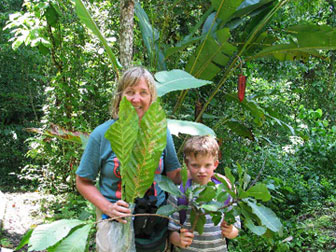 Lowman in Panama (2004) |
Lowman:
Please hurry! The rain forests needs bright, thoughtful students who love science but are also willing to work hard speaking to the public about important policy issues. And don’t forget to vote — our political leadership has a lot of influence on international conservation of forests and other ecosystems. Conservation starts at home and every student can educate those around him or her.
About Dr. Margaret D. Lowman
Dr. Margaret (Meg) Lowman is the Director of Environmental Initiatives at New College, the premier honors college for the State of Florida, and serves on Board of Directors for the Explorers Club. Lowman previously served as the Chief Executive Officer of Selby Botanical Gardens and was chief scientist for the Jason Project in Education (1995,1999, 2004). Lowman currently runs the TREE Foundation, a nonprofit organization that promotes Tree Research, Education, and Exploration both locally and globally for the stewardship of the planet.
Lowman has authored three books:
Its a Jungle Up There,
Life in the Treetops: Adventures of a Woman in Field Biology, and
Forest Canopies, Second Edition,
Lowman’s website is canopymeg.com